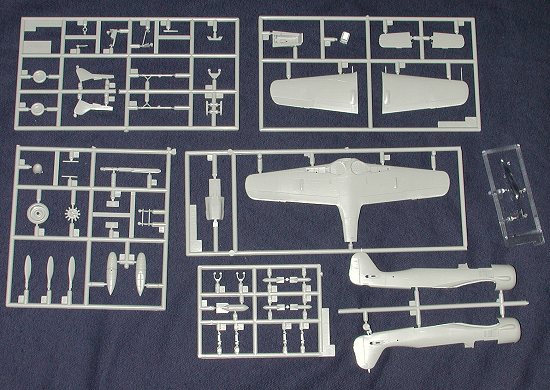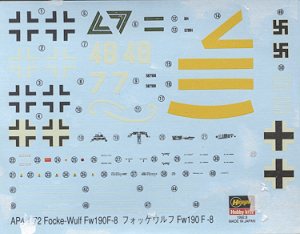
|
KIT: |
Hasegawa 1/72 Fw-190F-8 |
|
KIT # |
51304 |
|
PRICE: |
$12.98 |
|
DECALS: |
Three aircraft |
|
REVIEW & |
|
|
NOTES: |
|

|
HISTORY |
The most widely produced model of the famed Fw-190 was the Fw-190A-8. This version had the speed, armor and armament needed to be a widely successful aircraft. One thing that it wasn't was that great a dogfighter at low altitudes, though it had a superlative roll rate. With the advent of the A-8, it was decided to make a fighter-bomber version of it on the same assembly line.
The initial fighter-bombers were just field modifications, however, it was decided to produce a dedicated variant and 18 F-1s were built. These were based on the A-5 airframe as were the 270 F-2s and over a thousand F-3s (many of which had A-6 wings) that followed. The F-4, 5, 6, and 7 were all abandon and the next version was based on the A-8. The F-8 was built in larger numbers than any other Fw-190 fighter-bomber. It was identical to the A-8 other than the addition of bomb racks and the deletion of the outer wing guns. Just for those of you wondering where the 190G series comes into play, the Fs were all relatively short range aircraft. The G series had an increased fuel capacity which allowed a greater range. That, in a nutshell is the main difference.
|
THE KIT |

Always seeking ways to extend the use of a mold, Hasegawa simply added a sprue or two to the Fw-190A-8 kit, pop in a new decal sheet and you have a new kit! What has been added to this one is a sprue that contains the outer wing racks and their bombs. There is also a bomb for the centerline rack to replace the fuel tank. In addition, the kit includes the larger 'blown' canopy. It would have been nice had Hasegawa also included the earlier flat canopy, as the larger canopy wasn't introduced until January of 1945, and the F-8 left the production line in March of 1944. This means you are rather limited in terms of aftermarket decals to late war examples unless you find a replacement canopy.
The instructions are quite good and show you what needs to be done to build an
F-8 from the kit. This is mostly removing the outer wing gun shell ejection
chutes, filling in the barrel openings, and opening up the wing rack holes.
Interestingly, two of the three decal options still have the upper wing gun
bulges.
Speaking of decals, my kit was bought second hand and had obviously gotten more humidity than I would have liked (which accounts for the cheap price I paid). There are options for three aircraft, all of the very late war. They are shown as being in RLM 74/76/76, but frankly, I would bet they were in late war colors as they all would have come off the assembly line no earlier than January 1945 because of the blown canopy. Anyway, two are from unknown units and one from SG 2. The box art aircraft has a decal for the yellow nose band, but getting it to fit would be a real challenge. I'd recommend painting it on as you have to do that for the rudder anyway. This aircraft has the yellow under wing V marking for the Hungarian Front. The other is White 48 with a partial yellow tail band and White 7 from I/SG 2, also with a yellow tail band.
|
CONCLUSIONS |
This is a kit that can really be recommended to just about any modeler. The fussy will add the usual resin and etched brass stuff and the rest of us can be happy with the kit as it comes in the box. It makes for an accurate model and is a nice build.
|
REFERENCES |
Close-up #8: Fw-190F, Monogram Publications, 1986
Review kit courtesy of my kit collection.
If you would like your product reviewed fairly and quickly by a site that has over 100,000 visits a month, please contact me or see other details in the Note to Contributors.